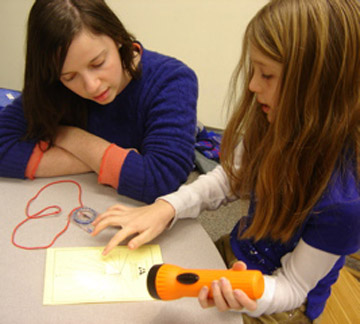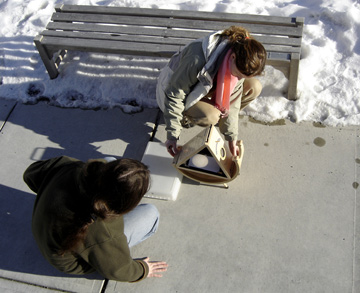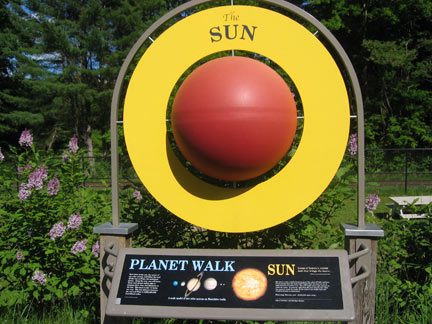Hands on the Sun at Montshire Museum (December 2007)
I'm Rachel Donegan, one of a team of four educators at the Montshire Museum of Science in Norwich, Vermont. The museum houses two floors of hands-on science exhibits highlighting physical and natural history and includes 110 acres of trails and outdoor exhibits along the Connecticut River. The Montshire Museum ( www.montshire.org) is located just across the river from Dartmouth College.
We are a popular destination for school groups from Vermont and New Hampshire, many of whom also participate in one of our many hands-on science workshops (about 1800 students and adults have participated in our astronomy workshops in 2006). One of these, "Here Comes the Sun," is an hour-long workshop about daytime astronomy for students in grades 3 through 7. Starting out in our classroom, we use an inflatable globe to represent Earth and a student volunteer, holding a light bulb, as the sun.

The students supply the details, which often lead to some interesting "teaching moments," as we encounter misconceptions children hold about how the sun and Earth interact. Before long, we have all worked out a model showing the correct motion of Earth around the sun. We discuss our place on the globe, night vs. day, and the reason we observe different constellations in the southern sky during different times of the year. The process of showing rather than telling really increases their understanding.

The real fun takes place outside, where we do some real observing. The class splits up into groups to attempt different investigations at various stations. One group uses wooden blocks to trace shadows on brown craft paper, while another group uses the Sun Spotter, an easy to use Keplerian telescope, to see an image of the sun, including sunspots. That's me in the photo, wearing a pink scarf, helping a student adjust the Sun Spotter.

My favorite part of this activity is to have a student volunteer trace the outline of the image of the sun (very carefully, so we get a perfect outline!) on the piece of paper where the image is projected. Inevitably, as the sun's image rapidly moves across the paper, the student cannot get the two ends of the circular outline to meet up! This causes the whole class to realize how fast the sun appears to move across the sky. "Is the sun moving across the sky right now?" I ask the group. "No," they quickly respond, remembering the classroom inflatable globe/light bulb model. "The Earth is turning!" Our Planet Walk outside also helps put the sun and our solar system in perspective.

I enjoy helping students make the connection between their observations and what scientists observe and what they learn. Back in the classroom, we project and explain SOHO images and our own set of shadow images taken on the museum grounds. Now that everyone has a grounding in hands-on observing, they can further their experience of shadow motion, sunspot activity, and other solar phenomena, such as aurora, in the classroom. It's exciting for students to directly see how their own solar observations "match up" with the observations made by an advanced telescope that's out in space! We do receive lots of thank you's from the students and compliments from teachers after our program.
TELL US ABOUT YOUR ACTIVITIES: If you use our SOHO images or movies, provide outreach and programs in the area of solar study, and would like to be considered for our Outreach Spotlight section, write to steele.hill[at]gsfc.nasa.gov with a brief overview of your efforts. If we think you'd make a good candidate, we will contact you.


